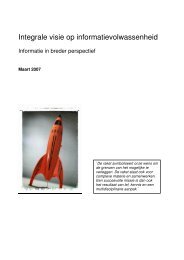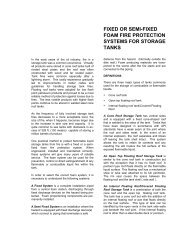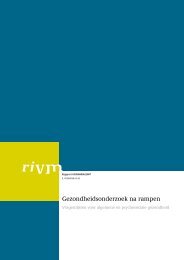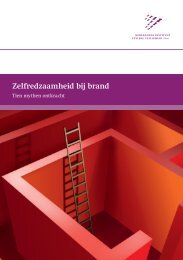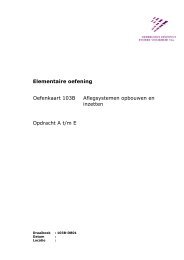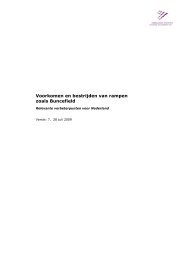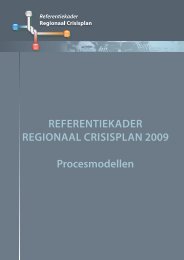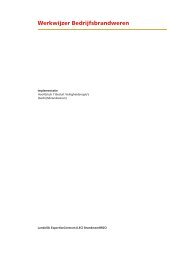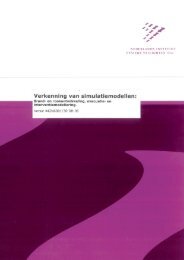LASTFIRE November 2001 - NIFV
LASTFIRE November 2001 - NIFV
LASTFIRE November 2001 - NIFV
Create successful ePaper yourself
Turn your PDF publications into a flip-book with our unique Google optimized e-Paper software.
<strong>LASTFIRE</strong>Large Atmospheric Storage Tank FiresSummary/Update<strong>November</strong> <strong>2001</strong>
In-House Experience & Expertise•Hands-on Emergency Incident Experience•Fire Science Knowledge•Fire Research•Fire Systems Operational Knowledge•Fire Systems Engineering•International Standards Committee members•Qualified Trainers•Fire Effects Modelling•Comprehensive Applications Expertise•Process Knowledge•QRA/HAZID/HAZOPs•AutoCAD Capability/Hydraulic Calculations•Emergency Exercise Management
Experience in more than40 countriesPolarTemperateDesertTropical
<strong>LASTFIRE</strong>Large Atmospheric Storage Tank Fires
<strong>LASTFIRE</strong>PROJECT SPONSORS Agip Petroli BP Conoco DEA Elf Exxon MOL Mobil OMV PetroFina Repsol Saudi Aramco Shell Total Veba WRG
<strong>LASTFIRE</strong>PROJECT STRUCTURESponsors’Steering GroupProjectCo-ordinatorProjectWorking GroupExternal Information SourcesOperatorsTank BuildersSeal ManufacturersDetection SuppliersProtection SuppliersFire FightersLegislatorsInsurers
<strong>LASTFIRE</strong>OBJECTIVES Determine current levels of risk Establish Design & OperationalPractice & make knowledge availablethroughout industry Establish techniques to determine site-specific levels of risk and identifyappropriate & cost-effective riskreduction measures
<strong>LASTFIRE</strong>Ignition SourcesHazardous MaterialsFireScenarioAnalysisFIRE HAZARD MANAGEMENTIncident DescriptionsEvaluate AlternativePrevention, Protection& Mitigation MeasuresCompare RiskReductionOptionsFormalisationLegislationDefineFHMPolicyEquipment MaintenancePreplanningExercisesFire TrainingUpdateImplementCONSEQUENCESLife SafetyEnvironmentFIRE ENGINEERINGBusiness InterruptionFIRE MODELLINGAsset ValueCOST BENEFIT ANALYSISOther IssuesHAZOPQRAINCIDENT EXPERIENCEDESIGN STANDARDSCODES OF PRACTICE
<strong>LASTFIRE</strong>BRAINSTORMING MEETINGS Firefighters Tank Builders SealManufacturers Operators Risk Analysts Detection Suppliers Protection Suppliers ExtinguishantSuppliers Insurers Legislators
<strong>LASTFIRE</strong>IncidentFrequencySurveyPROJECT DELIVERABLESFoamReviewRiskReductionOptionsDirect inputIndirect inputFireScenarioAnalysisCompare RiskReductionOptionsDefineFHMPolicyImplementEscalationMechanismAnalysisRisk Workbook
<strong>LASTFIRE</strong>MAIN PROJECT CONCLUSIONSFires in open top floating roof tanks shouldnot represent major risk to life safety or theenvironment if managed to preplannedstrategyMost cost effective risk reduction is goodfire related inspection & maintenancePrescriptive requirements cannot beuniversally appliedSite specific risk based policies should bedevelopedSlide 1 of 4
<strong>LASTFIRE</strong>MAIN PROJECT CONCLUSIONSFire incident probability & associated riskis relatively lowRimsealfires are most common scenario.They are unlikely to escalate to full surfacefires in well maintained tanksLightning is most common ignition sourceCorrelations between rimseal firefrequency & thunderstorm frequency havebeen developed. Typical frequency forNorthern Europe sites is 1x10 -3 /tank yearSlide 2 of 4
<strong>LASTFIRE</strong>MAIN PROJECT CONCLUSIONSGeneric event frequencies for fires otherthan rimseal fires are:-Fire TypeSpill on roofSmall bund fireLarge bund fireFull surface fireFrequency3x10 -5 /tank year9x10 -5 /tank year6x10 -5 /tank year3x10 -5 /tank yearSlide 3 of 4
<strong>LASTFIRE</strong>MAIN PROJECT CONCLUSIONSDetailed design of detection & protectionsystems is often incorrect due to lack ofoperational experience in design housesIncident response strategies must be developedprior to incident with regular exercises &trainingFHM policies should be developed from sitespecific analysis, but risk reduction options mostlikely to be cost effective are:-Secondary sealsFire retardant rimseal materialIndependent high-high alarmLinear heat detectionExtended discharge rimseal foam systemWalkways allowing foam application by handlinesSlide 4 of 4
FLOATING ROOF TANK FIRE SCENARIOSRimseal FireSpill on Roof FireFull Surface FireBund FirePontoon Explosion
<strong>LASTFIRE</strong>PROJECT DATABASE Data processed from 16 companies Completed questionnaires received from 164sites in 36 countries Data from 2420 tanks >40m diameter in useduring 1981-19951995 Average age of tanks reviewed - 27.1 years Sample represented 33909 tank years ofoperation
<strong>LASTFIRE</strong>SPILLS & INITIAL FIRE EVENTS<strong>LASTFIRE</strong>Loss of containmentOntoroofSunkenroofIntobundRimsealInitial Fire EventSmallbundLargebundSpillon roofFullsurfaceNumberofIncidents553796553211Frequency( x 10 -3/tank year )1.61.12.81.60.090.060.030.03
<strong>LASTFIRE</strong>RIMSEAL FIRE IGNITIONSOURCESNot recorded1Hot work on live tank252LightningTotal = 55
<strong>LASTFIRE</strong>RIMSEAL FIRE FREQUENCYBY AREACountry/RegionNigeria SouthernEuropeNorthernEuropeNorthSaudiAmericaVenezuela Thailand SingaporeArabiaNumberoffiresTankyearsFrequency( x 10 -3 /tank year )Thunderstormdays per year7 13 15 9 2 3 2 1333 6247 15264 4611 159 224 1035 339221 2 1 2 13 13 2 0.3160 30 20 40 60 70 120 10
<strong>LASTFIRE</strong>FULL SURFACE FIREANALYSISTotal of 6 full surface fires during 4 incidents☺ 1 escalation in 55 rim seal fires(Roof pontoons contained vapours and/or liquid)☺ 1 escalation in 2 bund fires impinging on tank shell☺ 1 escalation from a spill fire on the roof☺ 1 full surface fire in 37 sunken roofs incidents☺ Escalation to 2 downwind tanks in 1 full surface fire(Low boiling temperature fuel)☺ 1 boilover in 6 full surface fires
<strong>LASTFIRE</strong>RISK REDUCTION OPTIONSOptions addressed:- Tank & Bund Design & Operation Incident Detection Fire Protection Systems Portable/Mobile Fire FightingEquipment Fire Response StrategiesFinal options chosen should be based on site-specific specific analysis
<strong>LASTFIRE</strong>RISK REDUCTION OPTIONSFire related Tank Inspection Mechanical failure Electrical fittings Fire detection systems Fire protection systems Fire Fighting EquipmentIdeally, via a weekly walk-round checklist
<strong>LASTFIRE</strong>RISK REDUCTION OPTIONSFire retardant rimsealTank RoofTank RoofFire retardant rimsealFire containmentNon fire retardant rimsealFire spread
<strong>LASTFIRE</strong>RISK REDUCTION OPTIONSLinear Heat DetectorLinear Heat Detectorin rimseal areaTank RoofFIREFAULT1 2 3 4 5 6End-of-linedeviceSYSTEM ALARMFAULT SILENCEDSYSTEMHEALTHYRESETSILENCEALARMCONTROLENABLE
<strong>LASTFIRE</strong>RISK REDUCTION OPTIONSLinear Heat Detector - specification considerationsEnvironmental & Operating conditionsNormally no zoning required on tankNormally do not require back-up detectorMonitor for integrityCare with routing onto tank roofInclude additional length for easier repairInclude test mechanism
Linear Heat Detector - detector locationGood location - detector close to top of seal
Linear Heat Detector - detector locationPoor location - detector away from top of seal
Rimseal Foam SystemsFoam appliedtorimseal area
Rimseal Protection Systems“One Shot Systems”Limited application timeMaintenance issues
Rimseal Protection SystemsExtended Discharge SystemsLonger application time
Rimseal Foam SystemsFoam Concentrate Proportioning SystemsFully Fixed SystemSemi Fixed System
<strong>LASTFIRE</strong>RISK REDUCTION OPTIONSFoam Systems - Specification considerations Minimise system outlet blockage potential Cohesive foam discharge Foam dam higher than seal assembly Drain holes in foam dam Hydrant outlets at top of tank Ease of inspection/testing Correct proportioning at all possible flows Operator training
<strong>LASTFIRE</strong>RISK REDUCTIONPreplanning FormaliseOperator actionsFirefighteractions Training Exercises Systems/Equipment maintenance Update
Full Surface Fire ResponseOptions•Burn Down•System Application•Monitor Attack
Full Surface Fire ResponsePump-out and Controlled Burndown
Pump-out and Controlled BurndownExample•Shell, New Jersey
Note:Cooling monitors only
Note tank height!!!
Pump-out and Controlled BurndownConsiderations• Smoke• Public Image• Incident Duration• Pump out capability• Spare tankage• Flow rates• Exposure Protection• Boilover Potential• Prior Acceptance by Authorities
Full Surface Fire ResponseFull Surface Foam System
Full Surface Foam SystemExample•OMV, Austria
Full Surface Foam SystemConsiderations•Manning Exposure Minimised•Response Time Minimised•Cost•System Maintenance / Testing•Reduced Flow Rates•Foam Flow Issues if Tank > 60m
Full Surface Fire ResponseMonitor Application
Monitor AttackExamples•Sunoco,Sarnia, , Canada•Orion, USA
Monitor attack started
Norco Fire, June <strong>2001</strong>83m diameterGasoline Fire
Monitor AttackConsiderations• Manning Requirements•Numbers•Competencies• Personnel Safety• Radiant heat• Boilover• Bund access / footing• Logistics• Foam supply• Water supply• Allowance for Foam Losses (60%)• Drainage Issues
Full Surface Fire ResponseOptionsWhatever one you choosePREPLAN&EXERCISE THEPREPLAN!!
<strong>LASTFIRE</strong>Large Atmospheric Storage Tank FiresFollow-Up Work
Lightning Protectionof Floating RoofStorage Tanks
Main Issues• Proprietary equipment no guarantee!• Sparking at seals very likely• Shunts not usually effective• Ensure earth lead effectiveness
Poor ShuntContactGood ShuntContact
Earth leads are important!
LightningProtectionSystem
<strong>LASTFIRE</strong>Large Atmospheric Storage Tank FiresRisk Workbook
Risk WorkbookConsequencesXRisk 1FrequencyAdd FEHM measureConsequencesXRisk 2FrequencyIf ( Risk 1 - Risk 2 ) > Cost of measure,then cost benefit achieved
<strong>LASTFIRE</strong>RISK WORKBOOKCost Benefit AnalysisA Risk Reduction Option is cost beneficial if :-{( ) ( )}× γ - × γ × Pr >C withoutwithoutC withwithPrcontrolCost of implementa tionwhere:C without = Expected cost of incident without option in placeC with = Expected cost of incident with option in placeγ withoutwithout= Expected statistical frequency of the initiating event if optionis not implementedγ withwith= Expected statistical frequency of the initiating event if optionis implementedPr control = Probability that option will perform as requiredcontrol
An Easier Way….
Risk Workbook• Now updated• Computerised version available• 4 analyses• Rimseal Fire• Spill / Partial Surface Fire• Full Surface Fire• Bund Fire• Database• Help / Advice
IntroductionandGuidanceTank Identificationand SizeRisk MitigationOption Selection
Fighting Floating Roof TankRimseal Fires
• Made by Fire-fighters for Fire-fighters• Draws extensively from <strong>LASTFIRE</strong>Project knowledge• Practical guide to fighting rimseal fires• Fire-fighting strategies outlined• Guidance on creating pre-fire plans forrimseal scenarios
Scenes from <strong>LASTFIRE</strong>Video - ‘Fighting FloatingRoof Tank Rimseal Fires’
Foam Fire Test ForStorage Tank Fires
Foam Fire Test For Storage TankFiresComprehensive test specification developedFoam fire test exclusively for tank applicationEntirely relevant test:Critical application ratesRealistic application methodsRealistic foam propertiesEasily set-upAdaptable to suit fireground needsProven to differentiate between foams
2.44m DiameterFire Test Pan
RealisticApplicationMethodsRealisticFoamProperties
‘System’Application
Rapid Knockdown but PoorSealing Capability
Excellent BurnbackResistance
Tank FirefightingWorkshop
Tank Firefighting WorkshopObjectivesTo provide general site familiarisationTo increase knowledge of tank fire scenariosTo review tank fire response strategy/tacticsOptionsStrategiesTo practice response tacticsFire Training GroundTank FarmTo review plans for tank Fire Hazard Management
Tank Firefighting WorkshopProgramme - Day 1Tank types and fire scenariosTank incident videosFirefighting foam and foam systemsTank Fire hazard management (FHM)Protection/detection systemsFire modellingPreplanningTankFire Response TacticsFuture Tank FHM
Terminal FamiliarisationExercise Overview and Safety FeaturesTraining Ground – rimseal fire simulatorTank Farm – response ExerciseDebriefTank Firefighting WorkshopProgramme - Day 2
On the TrainingGround
Rimseal FireFightingTactics
FullCircumferenceRimseal FirePartialCircumferenceRimseal Fire
2 Man Attack At All TimesUsing Foam Extinguishers
Rimseal FireResponseSimulator
Briefing Session
Dry Chemical Attack
Note Flashback!
Handheld Foam Extinguishers
Foam Handline
Tank Farm –Response Exercise
ExerciseBriefing
ExerciseBriefing
Water spray/cone willallow team to access windgirder/walkway.Spray handlines may needto move with team.
Avoid water diluting foamstream or foam application
More Information about <strong>LASTFIRE</strong> Deliverablesfrom:Resource Protection InternationalLloyd Berkeley Place, Pebble Lane, Aylesbury, BucksHP20 2JH, UKT: +44 (0) 1296 399311F: +44 (0) 1296 395669e-mail: ramsden@resprotint.co.ukwebsite: www.resprotint.co.uk





